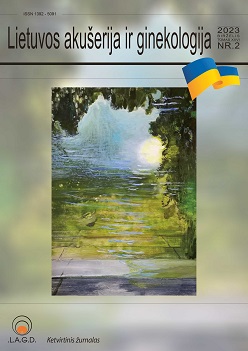INDOCYANINE GREEN MAPPED SENTINEL LYMPH NODE BIOPSY IN ENDOMETRIAL CANCER. WHAT FACTORS INFLUENCE THE SUCCESSFUL BILATERAL MAPPING?
Abstract
Summary. Aim. To evaluate the factors that might influence the successful bilateral sentinel lymph node (SLN) mapping with indocyanine green (ICG) in endometrial cancer patients. Methods. The prospective study was performed in the Hospital of Lithuanian University of Health Sciences, Kaunas Clinics, Department of Obstetrics and Gynaecology. 200 patients with histologically confirmed endometrial carcinoma were included. ICG was injected into the cervix before the surgery for SLN mapping. After the surgery patients were divided between successful and unsuccessful bilateral SLN mapping groups. Clinical data about the patient, tumour and surgery was collected for statistical analysis, and compared between the groups trying to identify factors associated with successful bilateral mapping. Results. Successful bilateral SLN mapping was achieved in 143 (71.5%) patients, 37 (18.5%) – had unilateral mapping. In 20 (10.0%) cases SLN mapping as unsuccessful. Univariate analysis showed that successful bilateral mapping was more likely in younger (63.0 vs. 65.0 years; p = 0.038) patients and those with lower BMI (29.4 vs. 31.1; p = 0.015). Deep myometrial invasion (39.2% vs. 56.1%; p = 0,029) and the adhesiolysis performed before SLN biopsy (13.3% vs. 28.1%; p = 0,013) were associated with mapping failure. The bilateral SLN mapping rate significantly increased with increasing number of procedures performed. After binary logistic regression, the only significant factor associated with bilateral mapping success was the case-load of SLN biopsies performed with odds ratio of 1.117 with each additional 10 procedure. Conclusions. The experience of the surgeon in SLN biopsy procedure and the case-load was the only significant factor associated with bilateral sentinel lymph node mapping success.

